

Do you need to take some time off work for a period that’s longer than your usual holiday allowance?
Whether it’s for personal reasons, illness or to further your education, asking for extended leave can be a tricky and nerve-wracking situation. Whatever your reasons, it’s important to stop putting off the inevitable and put in your request as soon as possible.
To help you out, we’ve put together this in-depth guide with tips and tricks on how to format your leave of absence request letter and, most importantly, get the answer you want.
TABLE OF CONTENTS
A leave of absence is when an employee temporarily steps away from work due to a significant life event or an unexpected circumstance. The duration of the leave of absence can vary, ranging from several days to a number of weeks or even months, depending on the circumstance of the employee. It's worth noting that a leave of absence is typically understood to be temporary, as the employee expected to return to their job at a later date.
Common reasons for taking a leave of absence include adopting a child, giving birth, caring for a family member, managing a serious health condition, mourning the loss of a close family member, military service, pursuing further education, or relocating to another state or country. Understanding the various reasons and policies related to a leave of absence can help both employees and employers navigate these challenging situations effectively.
A leave of absence letter can be a physical document or an email that an employee submits to their employer to request time away from work due to a big life event. As such, it is a formal letter that needs to be concise, free of errors and submitted well in advance (at least where possible) to the employee’s manager or boss.
Maintaining a professional tone is essential when writing a leave of absence letter, and so is sticking to a an easy-to-follow structure. In most cases, around three short paragraphs are sufficient to state the reason why you’re requesting time off, specifying the dates on which you’ll be away, and suggesting how the team might handle your responsibilities while you’re out of the office.
Sometimes, life doesn’t go according to plan. Unexpected events, both good or challenging, can cause us to reconsider or shuffle around our needs and priorities so we can navigate big changes as best as possible. When that happens, a break from work can also be needed.
These are some of the most common circumstances that require employees to submit a leave of absence from work:
Asking for leave can be a troublesome situation — after all, your employer won’t want a valued team member out for a long period of time. To make the situation a little easier for everyone involved, follow these tips:
If a member of your family has a life-threatening illness, for example, let your employer know early on, as they will expect you to take time off to bereave if that relation sadly passes away. Likewise, if you know you’ll need to be scheduled in for some kind of operation, do let your manager know as soon as you do.
In order to get approval for that vacation of a lifetime or a medical leave that you badly need, you’ll have to speak with your manager before sending a formal application.
This is best done face-to-face and in private, away from your other colleagues. Send your boss an email or IM and ask for a quick chat when it’s convenient for them.
If you work in a remote setting, however, you should ask your manager to have a call with you before you put anything in writing. It’s important to keep your communication levels high and maintain personal contact.
Be as transparent as possible by being honest about your time off.
If it’s to further your education, for example, make sure you explain how it will benefit the company in the long run. However, if your leave of absence is for an illness or to look after a sick family member, you don’t have to go into much detail if you do not feel comfortable doing so.
Let your supervisor know how you plan to distribute your work while you’re away.
You can take a plan of action with you, where you have delegated tasks to other team members that can continue those duties while you’re away. This will show that you have been proactive and that you care about your responsibilities.
If you’ll still be able to work remotely during this period of time, let your employers know. This will benefit both you and them, as you will earn an income and get the work done, meaning the company won’t have to hire a temporary replacement.
Under the Family and Medical Leave Act (FMLA), certain eligible employees in the US are entitled to up to 12 weeks of unpaid, job-protected leave per year. It also mandates that employees’ group health benefits are maintained during this time.
Reasons to take FMLA leave include:
Bear in mind that, according to the FMLA, you’re required by law to provide 30-day advance notice in writing if your leave of absence is predictable (such as the anticipated birth of a child). In an emergency situation, however, this 30-day requirement is waived.
Depending on your contract with your employer, after a few years of working there, you should be entitled to a sabbatical (unpaid leave) for up to three months. Your allowance may vary in accordance to your company’s policies, so it’s important to check the fine print to see what your rights are before you place a formal request.
UK employees are entitled to the same benefits.

When writing a formal leave of absence letter, you must follow some formatting rules to make sure it’s presented in a clear and professional manner.
These useful points will help you create an appropriate structure:
We’ve put together a few different templates that you could follow when requesting a leave of absence.

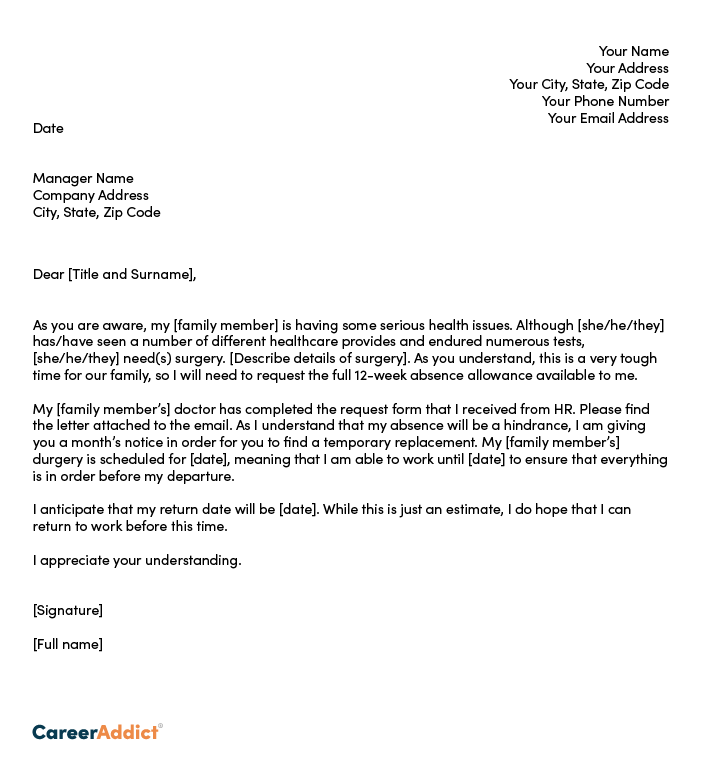
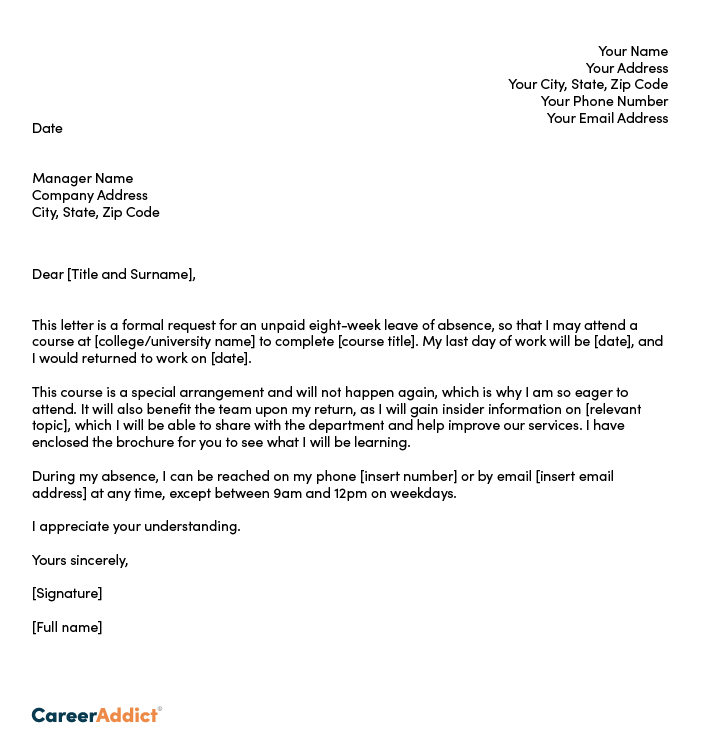
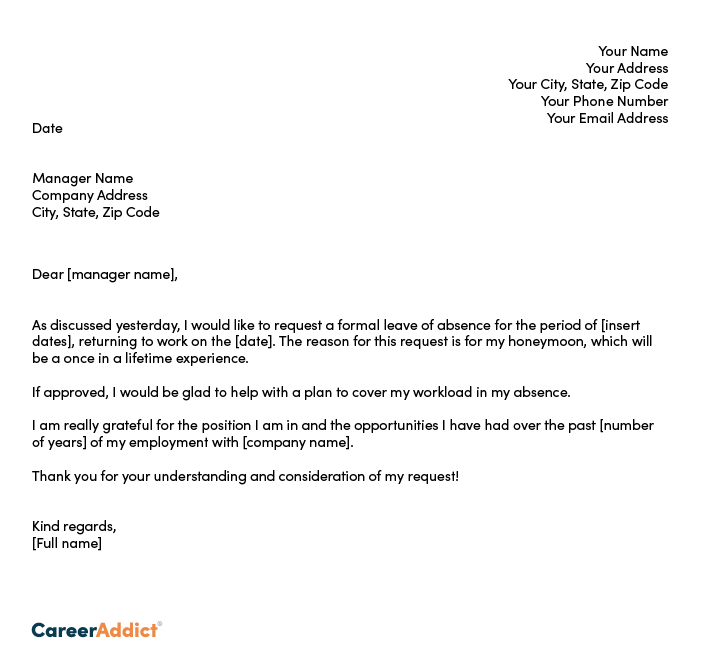
If you want to keep your reason private:
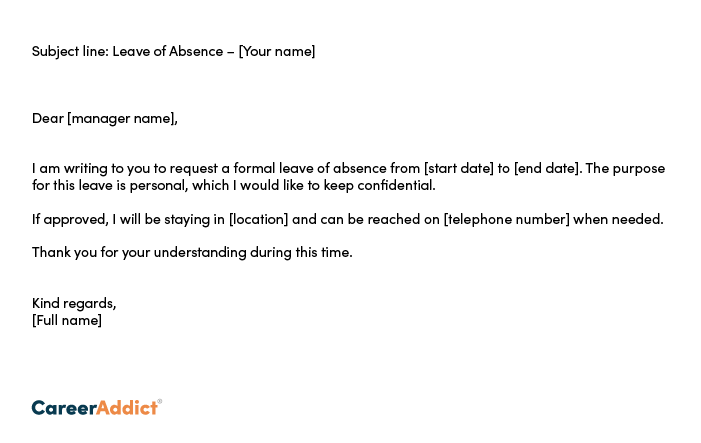
If you don’t mind sharing your reason for your absence request:


If you need some help getting started with writing your leave of absence request, use our customizable template to simplify the process:
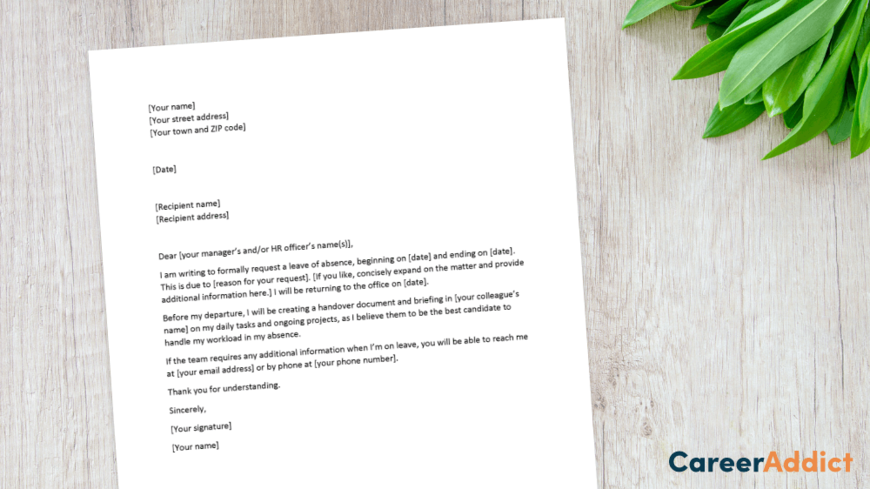
When it’s time to write a leave request and hand it in to your employer, bear in mind the following four points to ensure that the process goes smoothly:
Remember to give a copy of your request to the HR department — they’ll need this information for your personal records. They may also be able to assist with your application, as they’ll be involved in finding a temporary replacement depending on the specific circumstances.
Be sure to proofread your request before you send it to your employer, ensuring that you have the correct information and dates, and have made valid and clear points.
If you haven’t heard back straight away, don’t panic, and don’t begin to hassle your manager for an answer. Give it some time for the decision makers to deliberate before they get back to you.
Before leaving your job, you’ll need to think about how your tasks will be handled until you’re able to return to work. Starting as early as you can, prepare a detailed, clearly written document a colleague can refer to when taking over your tasks and projects, outlining the tools and processes you use and your deliverables.

To ensure that you don't forget anything in the process, save this checklist to stay organised.
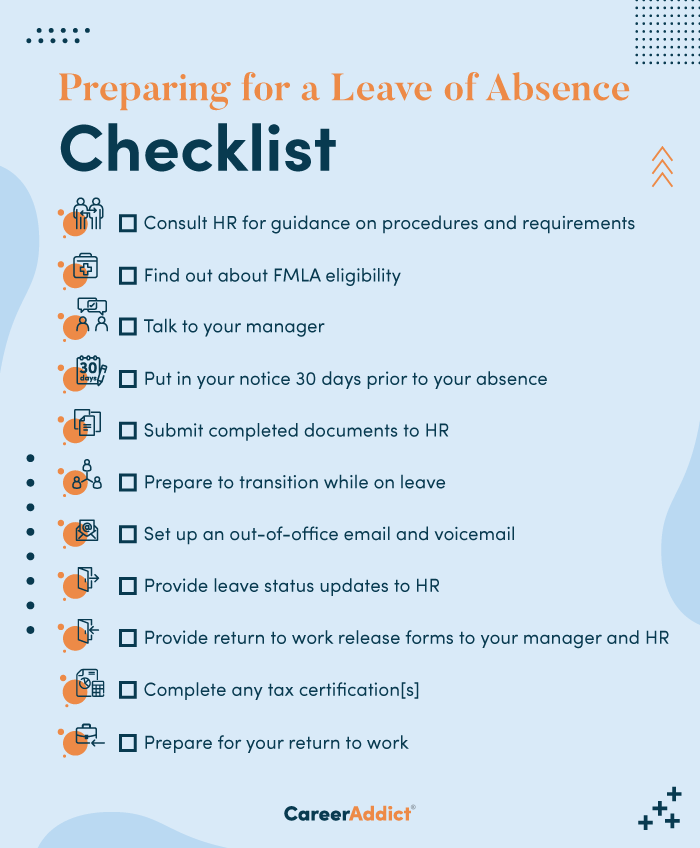
Asking for an extended period of time off can be stressful, but remember that you’re legally allowed to do so if you have a valid reason. By following this guide, you’ll ensure that you do it in the most professional and considerate manner.
Have you recently requested a leave of absence? If so, let us know how you placed your application in the comments section below.
Originally published on February 13, 2020. Updated by Electra Michaelidou.
Joanna Zambas - Content Manager and Career Expert
Joanna joined the CareerAddict content team in 2017, and her role has evolved into a multifaceted one over time. In between managing our content strategy and orchestrating our digital marketing efforts, she takes the time to share her expertise in a variety of insightful and thought-provoking articles about résumé writing, HR, recruitment, social media, job search strategies and more. Joanna holds both a BA and an MA in journalism, and previously worked within a variety of fields including HR and recruitment, travel, fashion and entertainment. She’s also our in-house fashion guru and enjoys cooking up a storm in her spare time.
Joanna joined the CareerAddict content team in 2017, and her role has evolved into a multifaceted one over time. In between managing our content strategy and orchestrating our digital marketing efforts, she takes the time to share her expertise in a variety of insightful and thought-provoking articles about résumé writing, HR, recruitment, social media, job search strategies and more. Joanna holds both a BA and an MA in journalism, and previously worked within a variety of fields including HR and recruitment, travel, fashion and entertainment. She’s also our in-house fashion guru and enjoys cooking up a storm in her spare time.